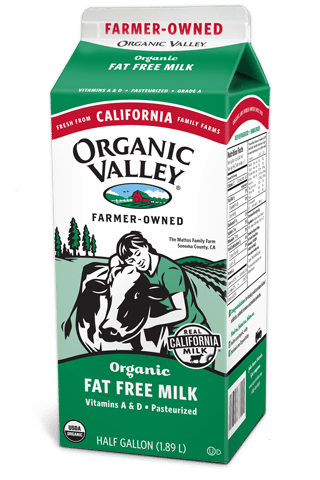Cow’s milk, goat’s milk, soy milk, rice milk, almond milk, hemp milk, coconut milk, and even grain milk — so many options on the market these days. So what should you be eating on your cereal or pouring into your coffee? Here are my recommendations:
- Unless you’re allergic to dairy or severely lactose intolerant, fat-free or 1% cow’s milk is the best option, as long as you’re choosing organic milk (here’s why organic is so important). Skim milk is an excellent source of naturally-occurring calcium, protein, and is low in calories. While it shows 12 grams of “sugar” on the Nutrition Facts Label, this sugar is lactose, and is not the same as added sugar (which all other milk substitutes have, unless you buy unsweetened).
- If you can’t have dairy for some reason, soy milk is the next best option, because it’s calorie and protein content are the most similar to cow’s milk. Again, it’s important to buy organic soy milk, because regular soybeans in the U.S. are often genetically modified. And the brand & flavor of soy milk makes a difference — some have significantly more sugar and less protein than others. Look for a type that has about 90 calories, 3-4 grams fat, at least 7 grams protein, and less than 6 grams sugar (this goes for both plain and vanilla).
Here are some examples of milks and their nutrition content per cup, so you can compare. This varies by brand, so make sure to check the Nutrition Facts Label before you buy a product.
|
Type of Milk |
Calories | Fat(grams) | Protein(grams) | Added Sugar (gms) |
| Cow’s (skim) | 90 | 0 | 9 | 0 |
| Soy (plain) | 90-110 | 4 | 7 | 6 |
| Soy (vanilla) | 100 | 3 | 6 | 10 |
| Rice | 120 | 2.5 | 1 | 10 |
| Almond | 60 | 2.5 | 1 | 7 |
| Hemp | 100 | 6 | 2 | 6 |
| Coconut (Lite) | 150 | 13 | 3 | 0 |
| Grain (unsweet) | 50 | 3 | 0 | 0 |
| Goat’s | 170 | 10 | 9 | 0 |
Notes:
- All of these milk substitutes (except coconut) are fortified with calcium, but only animal milks have naturally-occurring calcium, which is better absorbed by your body than the fortified kind.
- The reason the fat content in the goat’s milk looks so high is because it’s most often sold as whole milk, not reduced or low-fat. The same is true for goat’s milk yogurt.
- Cow or goat’s milk is the best choice for kids, unless they have a dairy allergy. It is generally recommended that kids drink whole milk until they’re 2 years old, then switch to low-fat (though different kids may have different needs).
- Avoid raw milk. In theory, raw milk is nutritious, but because most of us don’t raise dairy animals ourselves and are thus not in control of cleanliness and production conditions, it is better to avoid it. Raw milk has not been pasteurized, so it may contain listeria, which is a harmful bacteria and can be deadly. It is especially unsafe for children, the elderly, and pregnant or breastfeeding women.







17 Comments
Annie Averett
December 6, 2010 at 1:31 pmThank you for this insightful write-up Amelia! Over the summer I got complete grossed-out by some research that I did on cow’s milk, the treatment of the cows, the udder-infections, etc. – so I have been looking for good alternatives for our fam. I agree with you in that the *source of milk* is so important, and with that in place, the calcium and vitamins that it provides are worthwhile and hard to find elsewhere. Thanks again and keep up the amazing work!! Hugs, Annie
(Mostly) Healthy Mom
December 6, 2010 at 5:40 pmGreat post. People ask me all the time about the different milks they are trying, and I think this chart is great as a quick comparison. Though many of the alternative milks are fortified for calcium, most are lacking on the protein front, which is definitely important to keep in mind. I will definitely be keeping this comparison chart handy. Thank you! Ali
Amelia
December 6, 2010 at 5:54 pmSo glad you found it helpful!
Amelia
December 6, 2010 at 5:56 pmSo true about the source of dairy (just like the source of any food, really) being so important. It’s a shame that our food system has gotten so bad that people are turning to less nutritious, more highly processed options because they’re scared of regular food! I’m happy you found this info useful!
Deana
December 6, 2010 at 10:13 pmNot only is it the best nutritionally speaking, but it tastes the best too. I have some cartons of unflavored hemp “milk” gathering dust at home. Not delicious at all. Literally tastes like grass.
I do LOVE the taste of hemp seeds- maybe a topic for another post?
John
June 26, 2012 at 5:12 amThe advice you give is misleading and inaccurate according to The China Study. The extensive research referred to in the book shows cow’s milk is responsible for numerous diseases… Read the book.
Amelia
June 26, 2012 at 9:53 amThe science behind the China Study is indeed sound and impressive, and after reading it I too was convinced that we should all limit our dairy consumption. However the key is to not replace dairy in your diet with highly processed dairy alternatives. The China Study advocates for whole, unprocessed, plant-based foods. Really none of the milk alternatives listed here are whole or unprocessed. As always, it’s personal preference what you choose. I’m just reporting the science on the actual nutrients – and nutrient-wise, dairy milk is best.
Fox
April 10, 2013 at 9:46 pmRaw milk is actually best IF they come from ORGANICly GRASS fed Non-hormone cows…yeah!
Kerry
May 31, 2013 at 8:33 pmWhat about Kemps yogurt ice cream?
Dante
October 7, 2013 at 2:38 pmI mostly agree with everything on this article except that I know that whole milk is better for you than low fat or fat free, because the fat in the milk will enable your body to absorb the nutrients in the milk. It’s not bad fat, it’s good fat. But, other than that, so far, I love this site!!
Amelia
October 8, 2013 at 11:09 amThanks for stopping by, Dante!
Valerie Green
March 21, 2014 at 5:47 amCow’s milk or goat’s milk “may contain LISTERIA” is very misleading and not true. As a practitioner of public health and food scientist, I have done a review of food safety and analysis on this topic as I recently testified at a raw milk hearing in MD. Listeria has never and cannot ever reach levels of contamination in raw milk since the commensal flora outcompete. Pasteurized Milk, on the other hand, is a great culture medium or Cheese. Get your facts straight. The only people who have gotten sick or died from Listeria in this country are from PASTEURIZED milk or CHEESE.
Amelia Winslow
March 21, 2014 at 8:25 amWhat you’re saying is quite the opposite of what I’ve read in scientific research.
Heather
July 21, 2015 at 2:59 pmDid you know that without the fat content in the milk you cannot absorb the fat soluble nutrients? Never ever go fat free – of anything!
Amelia Winslow
July 23, 2015 at 2:36 pmAlthough if you have nonfat milk with any other foods containing dietary fat, or if you’ve eaten fat recently or eat it soon after, nutrient absorption shouldn’t be a problem. You just wouldn’t want to have a completely fat-free diet.
Patricia Nye
July 17, 2016 at 8:06 amNO ONE should drink “low fat” milk! You need to update your article! Milk fat is essential for brain function and maintaining a healthy weight! Low fat milk causes weight gain, diabetes, and many other death causing diseases ! Rewrite your article!
Amelia Winslow
July 21, 2016 at 3:26 pmI agree that whole milk offers some health benefits – and that we are seeing more research showing this lately. But I’ve never come across any science saying that low fat milk “causes” any of the conditions you mention – that’s nonsense. It’s true that when people don’t eat enough fat they often replace fat calories with refined carbs and sugar which isn’t healthy, and that going back to full-fat dairy products may help increase satiety so that sugar isn’t necessary. But the type of milk people choose is more about personal preference.